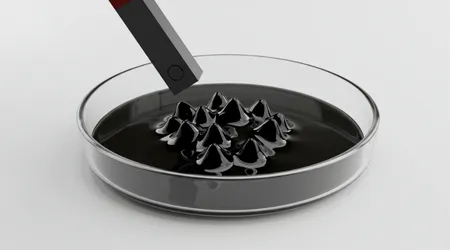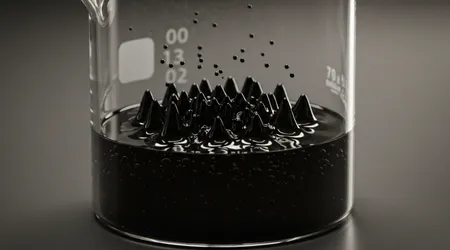The Science of Ferrofluid: Liquid That Reacts to Magnets

The Science of Ferrofluid captivates minds with its blend of liquid fluidity and magnetic responsiveness. Imagine a substance that flows like oil yet spikes into surreal shapes under a magnet’s pull.
Anúncios
Scientists first harnessed this in the 1960s. NASA engineers sought ways to control fuel in space. They created a magnetic liquid to defy gravity.
Today, researchers push boundaries further. In 2025, space missions test ferrofluid seals on rockets. These prevent leaks in zero-gravity environments.
Curiosity drives innovation here. How does a simple mixture transform into something so dynamic? Let’s dive deeper into its core mechanics.
Engineers mix tiny iron oxide particles with oil. A coating prevents clumping. Magnets then orchestrate the dance.
Anúncios
This interaction sparks endless possibilities. From art installations to medical tools, ferrofluid adapts cleverly. Have you ever pondered why liquids shouldn’t obey magnets? The Science of Ferrofluid challenges that notion entirely.
Recent studies highlight its eco-friendly potential. Teams explore cleaning microplastics from water using magnetic pulls.
In labs, ferrofluid forms bridges between physics and engineering. It bridges gaps in traditional materials science. Enthusiasts experiment at home too. A basic setup with magnets reveals its hypnotic spikes.
The Origins and Evolution
NASA’s Steve Papell invented ferrofluid in 1963. He aimed to pump liquids without mechanical parts in space.
Early tests proved successful. Rockets used it for fuel positioning during launches. By the 1970s, companies commercialized it. Seals in hard drives emerged as a key use.
Advancements accelerated in the 1980s. Researchers stabilized particles better for longer life. The 1990s brought biomedical applications. Doctors targeted drugs with magnetic guidance.
Into the 2000s, artists adopted it. Sculptures responded to fields in galleries. In 2010s, energy sectors joined. Dampers in speakers enhanced sound quality.
++ Transparent Aluminum: Sci-Fi Material Turned Real
2020s saw robotics integration. Ferrofluid enabled flexible manipulators. Now in 2025, space agencies revive interest. Projects like FINIX on REXUS 34 test thermal controls.
Universities collaborate globally. They refine compositions for harsher environments. Historians note its serendipitous discovery. A quest for space solutions birthed a versatile tool.

How Ferrofluid Works: The Magnetic Magic
Nanoparticles of magnetite suspend in carrier fluid. Surfactants coat them to avoid aggregation.
Apply a magnetic field. Particles align, pulling the liquid into peaks. This is Rosensweig instability. Fluid forms spiky structures defying gravity.
Remove the field. It relaxes back to smooth liquid state. Heat affects viscosity. Warmer ferrofluid flows easier under magnets.
Concentration matters too. Higher particle density strengthens response. Engineers calculate forces precisely. They use equations from magnetohydrodynamics.
Particles average 10 nanometers. This size ensures colloidal stability. Brownian motion keeps them dispersed. It counters settling over time.
Also read: The Hunt for the Fifth Force of Nature
Magnetic saturation occurs at high fields. Beyond that, response plateaus. Vary the carrier. Water-based versions suit biomedical uses. Oil-based ones excel in seals. They resist evaporation better.
Key Properties That Define It
Ferrofluid exhibits superparamagnetism. No remnant magnetism without field. Its density hovers around 1.2 g/cm³. This varies with composition.
Viscosity ranges from 2 to 2000 centipoise. Magnets can increase it dramatically. Thermal conductivity boosts by 50%. Useful for cooling applications.
It withstands temperatures up to 200°C. Beyond that, surfactants degrade. Optical properties shift under fields. It absorbs light differently.
Electrical conductivity is low. This prevents short circuits in devices. Biocompatibility depends on coating. Some versions are safe for bodies.
Read more: How Magnetic Fields Might Influence Human Behavior
Stability lasts years if stored properly. Avoid strong fields constantly. Environmental impact is minimal. Modern formulas use green surfactants.
Here’s a table summarizing core properties:
| Property | Typical Value | Notes |
|---|---|---|
| Particle Size | 5-15 nm | Ensures suspension |
| Density | 1.0-1.5 g/cm³ | Adjustable by carrier |
| Viscosity (no field) | 2-50 cP | Increases with field |
| Magnetic Susceptibility | High (superparamagnetic) | Aligns quickly |
| Thermal Conductivity | 0.2-0.6 W/m·K | Enhanced by nanoparticles |
This table highlights why engineers favor it. Analogous to a disciplined army, particles march in unison when commanded by magnetic generals.
Everyday and Industrial Applications
Speakers use ferrofluid for cooling. It dissipates heat from voice coils efficiently. In seals, it forms liquid barriers. Vacuum pumps rely on this for leak-proof operation.
Artists create interactive sculptures. Magnets beneath make fluid climb impossibly. Hard drives once depended on it. Though SSDs rise, legacy systems still do.
Automotive dampers employ it. Adjustable suspension improves ride quality. Sensors detect tilts accurately. Fluid shifts reveal angles precisely.
In recycling, it separates metals. Magnetic pulls sort scraps effectively. Optics benefit too. Tunable lenses adjust focus magnetically.
Aerospace seals prevent fuel leaks. Critical for satellite thrusters. Robotics grasps delicate objects. Ferrofluid molds to shapes softly.
One original example: Imagine a smart window shade. Ferrofluid blocks light when magnetized. Another: DIY magnetic putty for kids. It teaches physics through play.
Cutting-Edge Biomedical Uses
Doctors target cancer drugs precisely. Ferrofluid carries them to tumors via magnets. Hyperthermia treatments heat cells. Magnetic fields induce warmth selectively.
Cell separation speeds research. Labs isolate types magnetically. Imaging contrasts improve MRIs. Ferrofluid enhances visibility of tissues.
Wound dressings incorporate it. They deliver antibiotics on demand. Prosthetics gain flexibility. Fluid joints mimic natural movement.
Regenerative medicine explores scaffolds. Ferrofluid aligns cells for growth. Clinical trials advance in 2025. Europe tests drug delivery systems.
Safety profiles improve yearly. Biocompatible coatings reduce risks. Patients benefit from non-invasive methods. Magnets guide without surgery.
Researchers published in Nano Energy (2024). They detailed multifunctional robotics with ferrofluids. This study showed label-free manipulation.
Environmental and Sustainability Impacts
Ferrofluid cleans water of microplastics. Magnets pull contaminants out easily. Oil spill responses use it. It herds slicks for collection.
Soil remediation targets pollutants. Magnetic extraction purifies earth. Green synthesis methods emerge. Plant-based surfactants replace chemicals.
Recycling ferrofluid saves resources. Particles recover via centrifugation. Energy efficiency rises in devices. Less waste heat means greener tech.
A statistic underscores growth: The global market hits a CAGR of 4.6% through 2033. This reflects expanding eco-applications.
Carbon footprints shrink with it. Seals reduce emissions in industries. Wildlife protection benefits. Cleaner waters from magnetic filtration. Policy makers note its potential. Grants fund sustainable innovations.
Recent Advancements in Space and Tech
2025’s FINIX project launches on rockets. It validates ferrofluid in microgravity. Thermal management improves satellites. Fluid circulates heat evenly.
Quantum computing explores cooling. Ferrofluid dissipates quantum heat. AI integrates with it for soft robots. Machines adapt shapes dynamically.
Nanotech refines particle sizes. Smaller ones respond faster. Hybrid materials combine with gels. This creates semi-solid versions.
International Space Station experiments continue. Fargo project validated applications in 2024. Data from these inform designs. Engineers optimize for orbits.
Collaborations with xAI hint at AI-optimized formulas. Though early, promising. Challenges like evaporation addressed. New carriers extend life.

Future Prospects and Challenges
Predictions point to wearable tech. Flexible magnets in clothes. Quantum sensors advance with it. Precision measurements soar.
Challenges include cost reduction. Scaling production lowers prices. Toxicity concerns drive research. Safer alternatives emerge.
Integration with 6G tech possible. Magnetic data storage evolves. Educators push for curricula inclusion. Students build simple demos.
Global warming adaptations use it. Cooling systems combat heat. Ethical uses ensure benefits. Regulations guide biomedical apps.
Innovators dream big. Ferrofluid-powered engines? Partnerships accelerate progress. Industries fund university labs.
Wrapping Up the Magnetic Journey
The Science of Ferrofluid evolves rapidly in 2025. From NASA’s origins to space revivals, it amazes. We explored mechanics deeply. Properties enable diverse uses.
Applications span industries creatively. Biomedical and eco roles shine. Advancements like FINIX push frontiers. Future holds even more.
Challenges remain, but solutions brew. Innovators tackle them head-on. The Science of Ferrofluid inspires curiosity daily. It blends art, science seamlessly.
Reflect on its potential. What new wonders await discovery? The Science of Ferrofluid proves nature’s ingenuity. Magnets and liquids unite uniquely.
Enthusiasts, dive in. Experiment safely at home. The Science of Ferrofluid beckons explorers. Join the magnetic revolution. This liquid defies expectations continually. Its story unfolds excitingly.
Frequently Asked Questions
What exactly is ferrofluid?
It’s a colloidal suspension of magnetic nanoparticles in a liquid that responds to magnetic fields.
Is ferrofluid safe to handle?
Yes, with gloves, as it stains and some types irritate skin.
How can I make ferrofluid at home?
Mix toner with oil, but professional versions are safer and more stable.
What are the main applications today?
Seals, speakers, biomedical targeting, and environmental cleanup.
Does ferrofluid have any downsides?
It can evaporate or degrade over time in extreme conditions.
Where can I buy ferrofluid?
Online science suppliers like Educational Innovations or Amazon.
How does temperature affect ferrofluid?
Higher temps reduce viscosity, making it flow easier.
Is there ongoing research in 2025?
Yes, space projects and robotics dominate current studies.
Can ferrofluid conduct electricity?
Generally no, but some formulations might slightly.
Why was it invented?
NASA needed it for fuel control in zero gravity.
